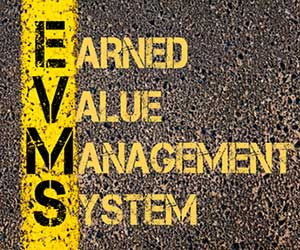
It’s amazing how many projects do not know their true status until near the end, when there is little that can be done to ensure they finish on time or budget.
The proper time to rigorously track project status is at the beginning, not at the end. This is when project risk can be managed and changes made to get it back on track.
Earned value analysis is the current buzzword for effective project control. It focuses on the two main variables that are inevitably crucial for every project.
- Schedule (time)
- Cost
There are 7 steps to performing earned value analysis effectively. It may seem like alot at first glance, but for small projects this takes five minutes once you learn how to do it:
- Determine the percent complete of each task.
- Determine Planned Value (PV).
- Determine Earned Value (EV).
- Obtain Actual Cost (AC).
- Calculate Schedule Variance (SV).
- Calculate Cost Variance (CV).
- Compile the results.
Before you get started, it is important to define appropriate project status points in which this calculation is performed. Weekly status meetings work very well, but whatever system you use make sure it is adhered to rigorously.
Determine Percent Complete
To start the process, the percentage complete of each task needs to be determined. Some project managers feel that each task should be sized so that the task can only be 0, 50, or 100% complete (not started, in progress, or complete). This prevents abuse when project team members exaggerate, for example they might tell you a task is 80% complete when it is really 50% complete. For repetitive tasks you can also use progressive measures such as number of fence posts installed. Whichever method you use, this is the primary input into the process and each task needs to be defined with a percent complete.
Determine Planned Value (PV)
Planned Value, also known as Budgeted Cost of Work Scheduled (BCWS), is defined as the amount of the task that is supposed to have been completed. It is in monetary terms as a portion of the task budget. For example,
- The task budget is $5,000,
- The task start date is January 1, and
- The task finish date is January 10.
If it’s January 6 today, the task is supposed to be 60% complete. PV = $5,000 x 60% = $3,000.
Determine Earned Value (EV)
Earned Value, also known as Budgeted Cost of Work Performed (BCWP), is the amount of the task that is actually complete. It is, again, in monetary terms as a portion of the task budget. For example,
- The task budget is $5,000, (same as above)
- The task start date is January 1, and (same as above)
- The task finish date is January 10. (same as above)
Let’s say the actual percent complete of the task (step 1) is 40%. EV = $5,000 x 40% = $2,000.
Obtain Actual Cost (AC)
The Actual Cost, also known as Actual Cost of Work Performed (ACWP), as you might guess, is the actual cost of the work. Generally employee hours need to be converted into a cost, and all project costs need to be added up, such as the following items:
- Labor
- Materials
- Equipment
- Fixed cost items, like subcontractors
Since most projects have these well defined via accounting or project management software, I will not go into great detail here. For the purposes of the next section, let’s say the actual cost of the example task is $1,500.
Calculate Schedule Variance (SV)
The Schedule Variance represents the schedule status of the project.
In our above example the schedule variance is: SV = $2,000 – $3,000 = -$1,000.
A negative schedule variance means the task is behind schedule. A positive schedule variance means it is ahead of schedule. The amount can be compared to worker charge out rates or similar metrics to get an idea of how difficult it would be to recover.
Calculate Cost Variance (CV)
The Cost Variance represents the cost status of the project.
In our above example the cost variance is: CV = $2,000 – $1,500 = $500.
A negative cost variance means the task is over budget. A positive cost variance means it is under budget.
Compile the Results
Once the individual task SV’s and CV’s have been calculated, they need to be added up into overall project variances. This represents the total variance of the project and can be reported to management, clients, and stakeholders.
Other Status Indicators
Although the SV and CV are the minimum requirement and work well for small projects, there are other variables that are derived from them which you might want to calculate:
- Schedule Performance Index (SPI): The schedule variance expressed in percentage terms, for example, SPI = 0.8 means the project 20% behind schedule.
SPI = EV / PV
- Cost Performance Index (CPI): The cost variance expressed in percentage terms, for example, CPI = 0.9 means the project is 10% over budget.
CPI = EV / AC
- Estimate at Completion (EAC): The expected budget at the end of the project given the variances that have already taken place.
EAC = AC + BAC – EV
- Estimate to Complete (ETC): The expected cost to finish the rest of the project.
ETC = EAC – AC
- To Complete Performance Index (TCPI): The required CPI necessary to finish the project right on budget. For example, TCPI = 1.25 means you need to find 25% efficiencies to finish on budget.
TCPI = (BAC – EV) / (BAC – AC)
Interpreting the Results
If the schedule variance is negative, you are behind schedule. If the cost variance is negative, you are over budget. The actual amount of variance can be compared to employee charge out rates or something similar to ascertain how difficult it might be to recover. The results are as instantaneous as the input data, that is if you input the percent complete as of right now, the status reported will be as of right now as well.
In our example the schedule variance was -$1,000 and the cost variance was $500. This means that the project is being schedule, but it is being performed efficiently and is cost-positive. If an auditor charging $75/hr was performing the majority of this work, they are about 13 hours behind schedule. This requires a couple days of work over and above the regular schedule to get back on track.
Graphing the results over multiple status points is a very helpful exercise. Good project control often means that the instantaneous project status snapshot is not as important as the trend the indicators are making over time. For example, if the SV has been increasing, then maybe the project will finish on time even though it’s behind schedule today.
It is a well understood concept that if projects fall behind early they will tend to struggle throughout their entire life cycle, and earned value analysis will give you that picture.






